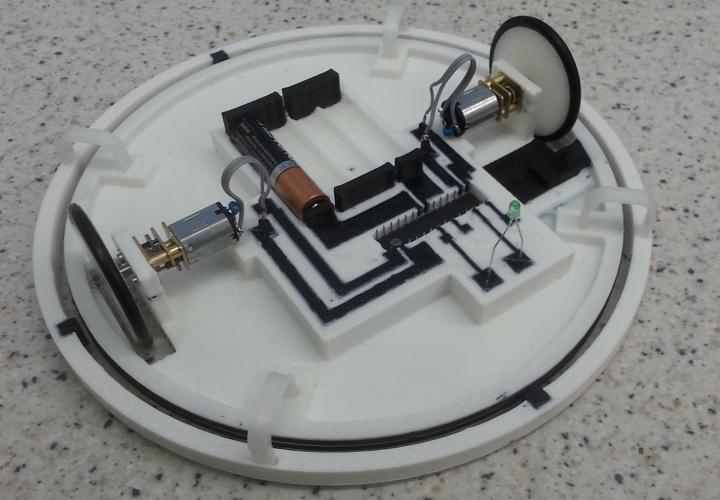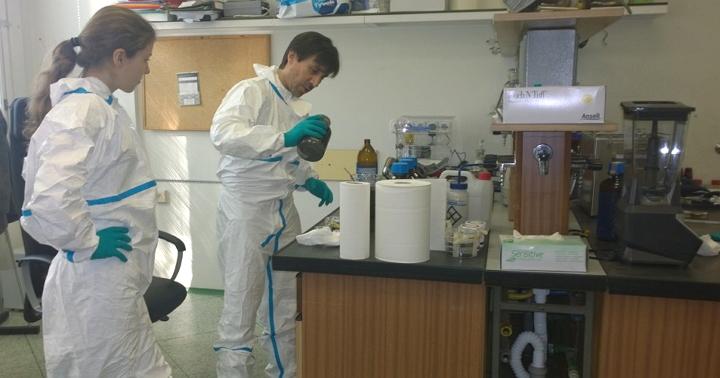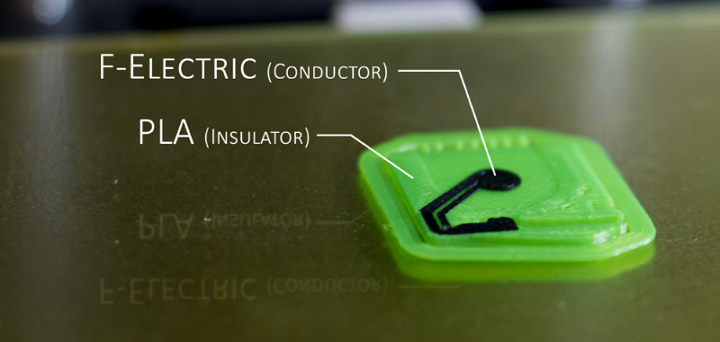Mike Toutonghi was working on a school project with his son when it struck him that there might be a better way to make a structural and electronic part. The pair’s work on an electromagnetic rocket compelled the computer software industry vet to form his company, Functionalize. When a long session of soldering the electronics for the rocket during the design and prototype process was finally over, Toutonghi looked to 3D printing to solve the tedious problem.
 What he found surprised him. There was no single 3D printer available on the market which would let him print circuits directly built into his plastic, 3D printed components. So Toutonghi took on the problem himself. He built a lab and equipped it to make graphene and nano-composite materials, and then began experimenting with an eye on incorporating those materials into various polymers.
What he found surprised him. There was no single 3D printer available on the market which would let him print circuits directly built into his plastic, 3D printed components. So Toutonghi took on the problem himself. He built a lab and equipped it to make graphene and nano-composite materials, and then began experimenting with an eye on incorporating those materials into various polymers.
The idea was to arrive at a formulation and process for a material that would be both capable of conductivity and that would 3D print smoothly.
Early in 2013, he formed his company and shortly thereafter filed for a patent on a method of producing nano-material composites which feature electrical, optical, magnetic and heat conductive properties. Now Functionalize Inc. says their F-Electric 3D printing filament is 25% more conductive than previous formulations – and it’s shipping to customers now.
Toutonghi says this final production material has a resistance of 0.75 Ω/cm and has greater mechanical strength than either his previous filament, or even virgin PLA. It’s been described as the world’s most conductive 3D-printing filament, and F-Electric plastic filament enables 3D printing of circuit boards, flashlights, lighted wearables and more.
The Functionlize filament features a volume resistivity of approximately 0.47 ohms/cm, and the materials can be used to create functional, 3D printable products that have electrical or mechanical capabilities.
Toutonghi says his company and its manufacturing partner, Protoparadigm, a supplier of premium 3D printing filaments, have now moved on from the limited, sample-only status of F-Electric filament and into full-scale production.
 According to Toutonghi, some interesting products have already been produced with F-Electric filament, including a flashlight built on a single-head printer by Mosaic Manufacturing, and a fully 3D printed robot by Adrian Bowyer, the CEO of RepRapPro Ltd. and founder of the RepRap project.
According to Toutonghi, some interesting products have already been produced with F-Electric filament, including a flashlight built on a single-head printer by Mosaic Manufacturing, and a fully 3D printed robot by Adrian Bowyer, the CEO of RepRapPro Ltd. and founder of the RepRap project.
“Imagine the possibility of today’s 3D-printed prosthetics being able to sense pressure through conductive pads in the fingertips, printable robots that people could share and improve, or active wearables as creative as their maker,” says Toutonghi. “Shipping F-Electric is a historic milestone for our company and our customers. We’ve provided a new tool, and I can’t wait to see what creative people do with it.”
One pound spools of 1.75mm F-Electric Filament retails for $142.00 on the Functionalize website.
Have you got any projects on the drawing board which would benefit from using F-Electric filament from Functionalize? Let us know in the Conductive F-Electric 3D Printing Filament forum thread on 3DPB.com.
Subscribe to Our Email Newsletter
Stay up-to-date on all the latest news from the 3D printing industry and receive information and offers from third party vendors.
You May Also Like
Precision at the Microscale: UK Researchers Advance Medical Devices with BMF’s 3D Printing Tech
University of Nottingham researchers are using Boston Micro Fabrication‘s (BMF) 3D printing technology to develop medical devices that improve compatibility with human tissue. Funded by a UK grant, this project...
3D Printing Webinar and Event Roundup: April 21, 2024
It’s another busy week of webinars and events, starting with Hannover Messe in Germany and continuing with Metalcasting Congress, Chinaplas, TechBlick’s Innovation Festival, and more. Stratasys continues its advanced training...
3D Printing Webinar and Event Roundup: March 17, 2024
It’s another busy week of webinars and events, including SALMED 2024 and AM Forum in Berlin. Stratasys continues its in-person training and is offering two webinars, ASTM is holding a...
3D Printed Micro Antenna is 15% Smaller and 6X Lighter
Horizon Microtechnologies has achieved success in creating a high-frequency D-Band horn antenna through micro 3D printing. However, this achievement did not rely solely on 3D printing; it involved a combination...
































